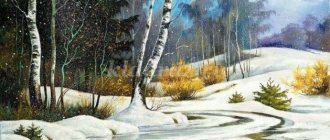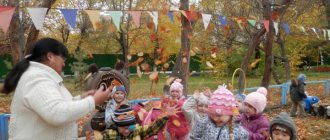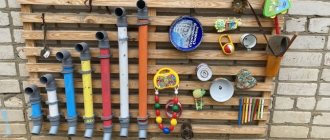Summary of educational activities at the weather site with children of the second junior group of the preschool educational institution “Solnechnye Luchi”
Summary of the lesson at the “Sun Rays” weather site.
Second junior group Second junior group Goal: development of observation of natural phenomena. Objectives: • teach to observe the phenomena of inanimate nature, analyze and draw conclusions; • expand and clarify children's knowledge about the sun, the properties of solar rays; • develop thinking, learn to independently draw conclusions based on observation results; • enrich and replenish your vocabulary. Preliminary work: learning greetings, talking about the sun, observing the heating of objects in the sun while walking, learning the outdoor game “Sunny Bunnies”. Weather conditions: partly cloudy, with bright sunshine. Equipment: mirror, bowl of water, sheet of white cardboard.
Progress of the lesson
Children and the teacher go to the weather site.
Educator: Guys, please tell me what the weather is like today? Children's answers. Educator: That's right - sunny, warm, clear. The sky is clear, the sun is shining brightly. Children mark the weather conditions on a weather stand. The teacher and the children read the poem: A cloud is hiding behind the forest, The sun is looking from the sky - And so pure, kind, radiant. If we could get him, We would kiss him. Educator: Guys, is it possible to get the sun? That's right, you can't! We can see the sunlight, feel its warmth and play with the sun's rays. Observation "Sunshine". The teacher takes out a mirror, uses the mirror to catch a ray and draws the children’s attention to how the sun’s “bunny” moves across the weather site. Educator: Look how quickly the sunbeam moves. Here he is on a bench on the sunny side, here he is in the shadows on the wall. Where is the sun's ray more visible in the shade or in the sun? Children's answers. Educator: Guys, our little ray of light has disappeared! What happened? Children's answers. Educator: That’s right, the sun hid behind a cloud, through which the sun’s rays cannot reach us. Look, the wind drove away the cloud, and the sunbeam returned to us! Let's play together with a ray of sunshine the fun game "Sunny Bunnies". Medium mobility game “Sunny Bunnies”. At the signal from the teacher “Sun”, children jump freely around the playground; at the signal “Cloud” they crouch and hide behind their palms. The game is repeated 2-3 times. Observation: “Warm and cold objects” Educator: Guys, you know that the sun not only shines, but also warms everything around. Look, the little ray jumped onto the bench. Oh, how warm it is! Touch the bench, what is it like: warm or not? What heated her up? Yes, sun rays! In the summer the sun is very hot - it also warmed up the bench. Now the bunny jumped onto the stones, into a basin of water. The children, together with the teacher, walk around the weather site and find out that the table, water in the bowl, fence, stand, etc. have become warm. Educator: What heated the objects? Children's answers. Educator: That's right, sun rays. Educator: Now let’s touch the bench (stand, stones) on the other side, what is it like? Children's answers. Educator: That’s right, in the shade, all objects are colder because the sun’s rays did not transfer their heat to them. Do you have a shadow? Children's answers. Shadow game "Shadows on the wall." Educator: You can come up with many fun games with the shadow. Using your hands, draw the shadow of a barking dog, flying bird, etc. on the wall. Educator: Well done guys! Let's look at our shadows again, what color are they? Children's answers. Educator: The color of the shadow is the same as that of the object on which it lies. It's just less bright. But all the colors of the rainbow are hidden in a ray of sunshine. Do you want to see them? Children's answers. Experiment "Rainbow Effect". We split visible sunlight into individual colors - we reproduce the effect of a rainbow. Procedure: Place a bowl of water in a sunny place. Place a small mirror in the water, leaning it against the edge of the bowl. Turn the mirror at an angle so that sunlight falls on it. Then, moving the cardboard in front of the bowl, find the position where the reflected “rainbow” appeared on it. Educator: Did you guys like playing with a ray of sunshine? What new did you learn today? Children's answers . Educator: Well done. That's right: the sun's rays heat and illuminate everything around you and me. Now I suggest you draw a rainbow on the asphalt with multi-colored crayons.
We recommend watching:
Summary of GCD in the 2nd junior group on the topic: Wild and domestic animals Summary of a mathematics lesson in the 2nd junior group on the fairy tale "Kolobok" Summary of a theatrical lesson in the second junior group Summary of GCD for familiarization with the outside world in the second junior group
Similar articles:
Short-term project at a preschool educational institution on the topic “Theatre. Music" Second junior group
Lesson notes for the 2nd junior group of kindergarten. Profession cook
Summary of lessons in kindergarten in the 2nd junior group. Doctor's profession
Summary of a lesson on social and communicative development in the junior group of kindergarten
Walk. Watching the movement of the sun
Lydia Narezhnaya
Walk. Watching the movement of the sun
Pedagogical goal: to develop the cognitive interests of children, to cultivate sustained attention, observation , and love of nature; consolidate knowledge about the parts of the day; develop rhythmic, expressive speech, reaction speed, running speed; precision of movements and eye .
Educational targets: shows interest in natural objects; is proactive in conversation, answers questions, asks counter questions; listens carefully to an adult reading; shows a desire for work activities, complies with the conditions of the game, and shows interest in a variety of physical exercises.
Educational areas being mastered: “Socio-communicative development”
,
“Cognitive development”
,
“Speech development”
,
“Artistic and aesthetic development”
,
“Physical development”
.
Observing the Sun. For what?
Ancient people made astronomical observations for two reasons. On the one hand, they were driven to do this by the needs of everyday life, such as determining periods of rain and drought. After all, it was the sky that could tell people when to start sowing and when to harvest. In tropical latitudes, this knowledge was especially valuable, since the rainy season there begins abruptly, and if you miss the right moment, it can result in hunger and terrible troubles for people.[1] On the other hand, the ancient inhabitants of Mesoamerica believed in the influence of celestial bodies and phenomena on the destinies of people. Many scientists have repeatedly focused on the fact that the ancient inhabitants of this territory were more astrologers than astronomers themselves.
What celestial bodies and phenomena could those who lived in ancient Central America observe? Those that are easy to see with the naked eye: the Sun, the Moon, Venus, Mars, Jupiter, stars and constellations, comets, solar and lunar eclipses, the annual cycle of the Pleiades.[2]
Priest watches the night sky, Codex Mendoza
In this article we will briefly look at several aspects related to the most significant of these objects - the Sun. Of course, the data presented here cannot be considered exhaustive on the topic. This is just a brief overview of the main problems and questions surrounding the place of the Sun in the cultures of ancient Mesoamerica. Thus, here we will touch on only one celestial object out of many studied by archaeoastronomers.
It is the Sun that determines our rhythm of life. The movement of the Sun throughout the year gives us four key dates: the autumn and spring equinoxes, the summer and winter solstices.
Movement of the Sun during the equinoxes and solstices
This picture shows the movement of the Sun for moderate latitudes. Here the Sun never reaches its zenith, and the center of the night sky is the North Star. Within the Tropic of Cancer (south of 23°26'N), the Sun typically reaches its zenith at its highest point on the day of the summer solstice. At latitude 23°26'N. The sun only reaches the zenith (that is, it is located directly above the observer's head), but in more southern latitudes (up to 23°26' S) the Sun passes through the zenith 2 times a year. The closer to the equator, the greater the interval between two passages of the Sun through the zenith.
If we observe the movement of the sun throughout the year at the same time and record our observation, we will eventually get the following picture (analemma).
For northern latitudes
For mid latitudes
The highest point of the analemma is the summer solstice. The lowest one is winter. The intersection point is April 15 and August 29. Just below the intersection point are the positions of the Sun on the days of the equinoxes. If for middle latitudes the analemma is located at an angle, then in the tropics it lies horizontally. This means that the ancient inhabitants of Mesoamerica did not think that on the days of the solstices the light was higher or lower; for them these two points characterized the extreme southern and extreme northern positions of the Sun.
Because of its position within the Tropic of Cancer, the latitude of Mesoamerica determines a number of features in relation to the observation of the Sun. If in more northern latitudes there are 4 seasons, then in the tropics there are only 2 (rainy and dry seasons). For this territory, such phenomena as the passage of the sun through the zenith play a very important role, as it is associated with climate. The first passage of the sun through the zenith marks the imminent onset of the rainy season, which is a necessary condition for sowing maize. This relationship is reflected in mythology and rituals.[3]
[1] Johanna Broda. Mesoamerican Astronomy and the Ritual Calendar, p.250\Science Across Cultures: The History of Non-Western Science. Volume 1 Astronomy Across Cultures 2000
[2] Johanna Broda. Mesoamerican Astronomy and the Ritual Calendar, p.234\Science Across Cultures: The History of Non-Western Science. Volume 1 Astronomy Across Cultures 2000
[3] Stanislaw Iwaniszewski. The Length of the Year in Maya Calendar and Astronomy, page 291\Anthropological Notebooks 2013, Year XIX, supplement



